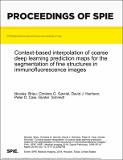Files in this item
Context based interpolation of coarse deep learning prediction maps for the segmentation of fine structures in immunofluorescence images
Item metadata
| dc.contributor.author | Brieu, Nicolas | |
| dc.contributor.author | Gavriel, Christos | |
| dc.contributor.author | Harrison, David James | |
| dc.contributor.author | Caie, Peter David | |
| dc.contributor.author | Schmidt, Guenter | |
| dc.contributor.editor | Tomaszewski, John E. | |
| dc.contributor.editor | Gurcan, Metin N. | |
| dc.date.accessioned | 2018-03-15T17:30:06Z | |
| dc.date.available | 2018-03-15T17:30:06Z | |
| dc.date.issued | 2018-03-06 | |
| dc.identifier | 252558377 | |
| dc.identifier | e43dbf84-03d3-4284-a6b6-763218d2f1c5 | |
| dc.identifier | 85049198877 | |
| dc.identifier | 000435479200023 | |
| dc.identifier.citation | Brieu , N , Gavriel , C , Harrison , D J , Caie , P D & Schmidt , G 2018 , Context based interpolation of coarse deep learning prediction maps for the segmentation of fine structures in immunofluorescence images . in J E Tomaszewski & M N Gurcan (eds) , Medical Imaging 2018 : Digital Pathology . , 105810P , Proceedings of SPIE , vol. 10581 , SPIE , Symposium: SPIE Medical Imaging , Houston , Texas , United States , 10/02/18 . https://doi.org/10.1117/12.2292794 | en |
| dc.identifier.citation | conference | en |
| dc.identifier.issn | 0277-786X | |
| dc.identifier.other | ORCID: /0000-0002-0031-9850/work/60196559 | |
| dc.identifier.other | ORCID: /0000-0001-9041-9988/work/64034350 | |
| dc.identifier.uri | https://hdl.handle.net/10023/12955 | |
| dc.description.abstract | The automatic analysis of digital pathology images is becoming of increasing interest for the development of novel therapeutic drugs and of the associated companion diagnostic tests in oncology. A precise quantification of the tumor microenvironment and therefore an accurate segmentation of the tumor extend are critical in this context. In this paper, we present a new approach based on visual context Random Forest to generate high resolution segmentation maps from Deep Learning coarse segmentation maps. Through an example inimmunofluorescence, we show that this method enables an accurate and fast detection of the tumor structures in terms of qualitative and quantitative evaluation against three baseline approaches. For the method to be resilient to the high variability of staining intensity, a novel locally adaptive normalization algorithm is moreover introduced. | |
| dc.format.extent | 6 | |
| dc.format.extent | 1173173 | |
| dc.language.iso | eng | |
| dc.publisher | SPIE | |
| dc.relation.ispartof | Medical Imaging 2018 | en |
| dc.relation.ispartofseries | Proceedings of SPIE | en |
| dc.subject | Digital pathology | en |
| dc.subject | Whole slide imaging (WSI) | en |
| dc.subject | Immunofluorescence (IF) | en |
| dc.subject | Deep learning | en |
| dc.subject | Random Forest | en |
| dc.subject | Interpolation | en |
| dc.subject | Semantic segmentation | en |
| dc.subject | RC0254 Neoplasms. Tumors. Oncology (including Cancer) | en |
| dc.subject | T Technology | en |
| dc.subject | NS | en |
| dc.subject | SDG 3 - Good Health and Well-being | en |
| dc.subject.lcc | RC0254 | en |
| dc.subject.lcc | T | en |
| dc.title | Context based interpolation of coarse deep learning prediction maps for the segmentation of fine structures in immunofluorescence images | en |
| dc.type | Conference item | en |
| dc.contributor.institution | University of St Andrews. School of Medicine | en |
| dc.contributor.institution | University of St Andrews. Cellular Medicine Division | en |
| dc.identifier.doi | https://doi.org/10.1117/12.2292794 | |
| dc.date.embargoedUntil | 2018-03-06 |
This item appears in the following Collection(s)
Items in the St Andrews Research Repository are protected by copyright, with all rights reserved, unless otherwise indicated.

